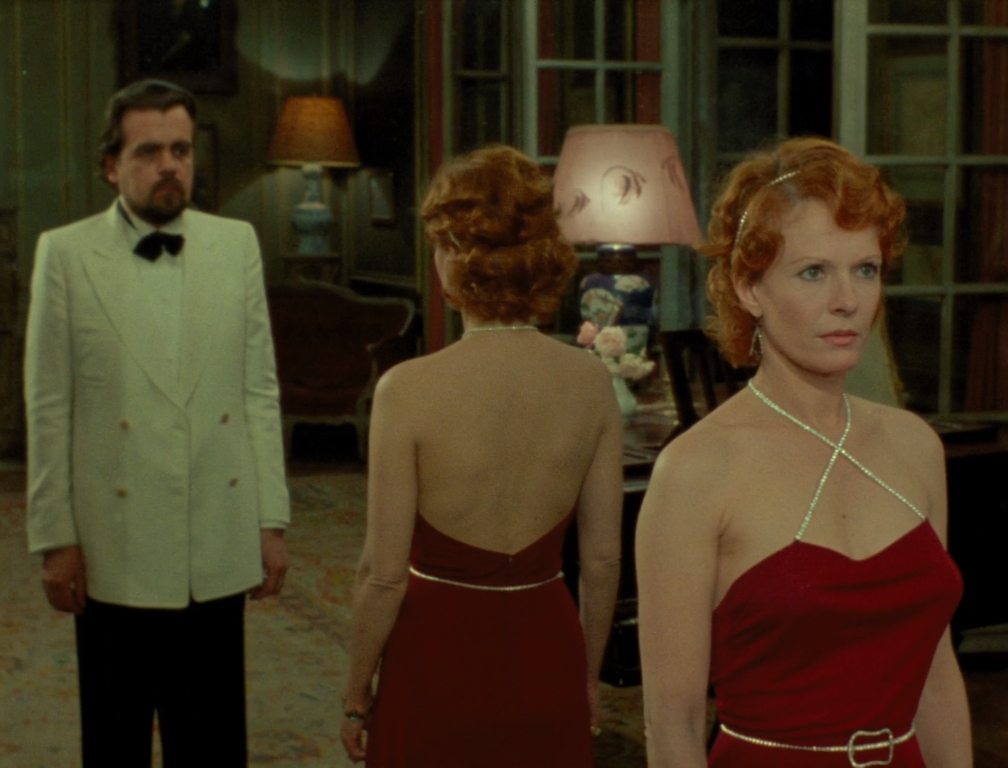
India Song
1975, directed by Marguerite Duras
“De quoi avez-vous peur?”
“Anne-Marie Stretter.”
These two lines preface Delphine Seyrig’s first appearance early in India Song, during a slow pan across the drawing room at the French Embassy in Calcutta where most of the movie is set. Whatever her fear of Madame Stretter may be, the off-screen speaker is safely removed from the ambassador’s wife. The narrating voices (“voix intemporelles”) comment on the last few days of Anne-Marie Stretter’s life in 1937, but they also note the worn-out inscription on her tombstone, placing them outside her time frame.
Of course there might be no connection between the two lines above. There’s a twenty-five second gap between them, and Anne-Marie Stretter’s name is pronounced with surprise as the pan reaches a framed photograph which might be Stretter in her youth. It’s reasonable to suppose that the question regarding fear is left unanswered – yet the ambiguity seems intended. There’s a similar juxtaposition much later when a narrator asks about a “smell of death” just as the vice-consul enters the scene. India Song is so replete with ambiguities that this one doesn’t seem quite accidental. Why, though, would Anne-Marie Stretter strike fear in someone so long after she’s dead?
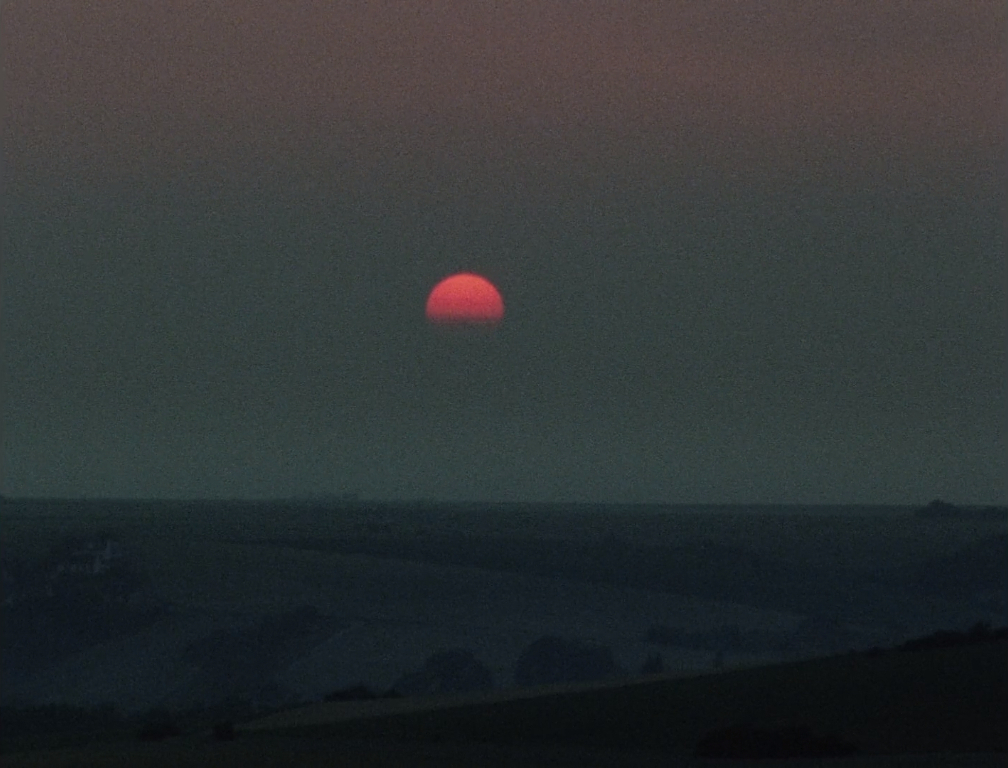
The question, however, asks not “who” but “what” you are afraid of… and the answer goes right to the point of the movie. It’s not Stretter herself who inspires fear. What’s terrifying is how easy it is to succumb to her fate, her “leprosy of the heart”. Leprosy numbs the nerves, and Stretter, a bored wife living in a world she cannot get used to, is numb toward life. Months earlier she and her lover Michael Richardson had attempted suicide in Chandernagore, reportedly her first attempt. Her next attempt is presumably at the end of the story when she drowns herself at the beach near the embassy villa.
When the narrators describe her first suicide attempt, their exchange hits on a word that illuminates the movie’s structure:
“Indifference to life.”
“Or the opposite. People confuse things.”
“No. There’s a definite equivalence.”
Here they seem to be questioning whether Stretter sought death because of boredom or an excess of passion. The key word is “equivalence” – boredom and passion seem to be opposites, but people are often bored precisely because of passions either thwarted or overindulged. India Song is built on a web of dichotomies: the West and the Orient, characters and narrators, past and present, image and sound, Calcutta and Venice, the Ganges and the Mekong, the actual French filming locations and the purported setting in Bengal, the house and the garden, Anne-Marie Stretter and the Laotian beggar woman. In each case there’s a real difference, but there’s also an important equivalence. Stretter and the beggar enjoy nearly opposite extremes of wealth and comfort; one is visible for most of the movie and the other is never seen; but each has her own madness, and both have taken circuitous paths from Savannakhet to Calcutta.
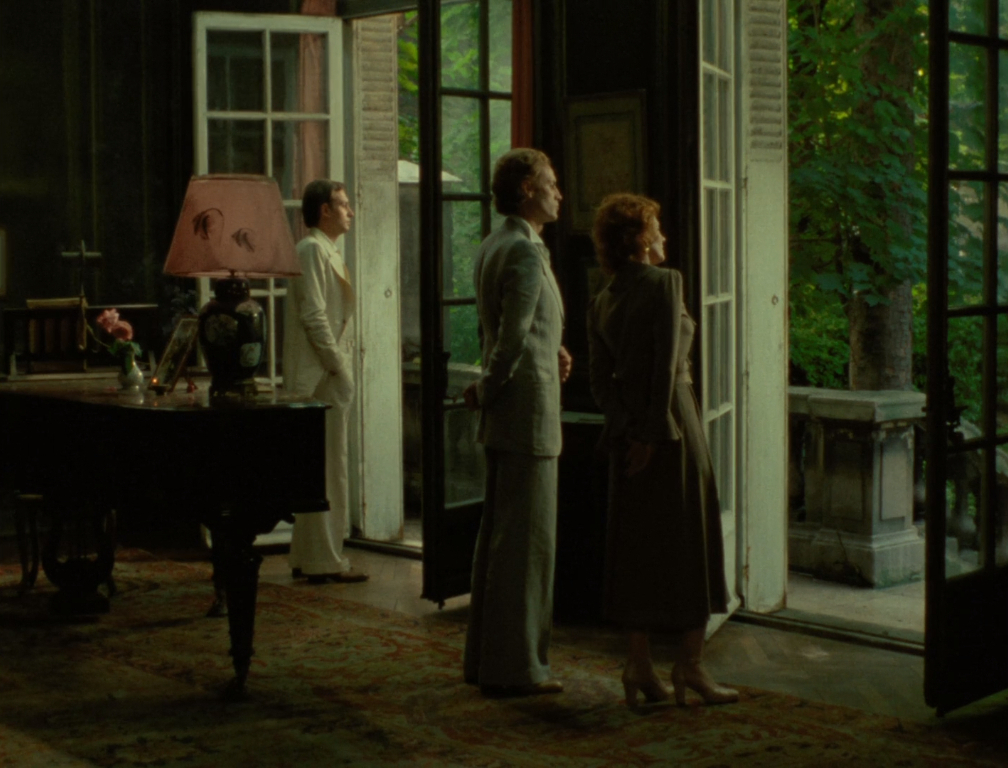
A profound equivalence also binds India Song‘s two most prominent characters: Anne-Marie Stretter and the disgraced vice-consul of Lahore, demoted to a post in Calcutta after losing his nerves one night and shooting lepers and dogs in the Shalimar Gardens from his balcony. On one hand she and he are hardly equal; Stretter still enjoys the dignity of her position, held “irreproachable” in spite of her extramarital affairs, and the vice-consul is wholly at her mercy, begging for her affections, rejected, kicked out of the embassy, and reduced to shouting in the streets. They differ even symbolically: he has no name while she has two. Nevertheless both of them are defined by their pain. Stretter will take her own life, and the vice-consul’s mortifying behavior shows every sign of suicidal desperation. In Lahore he had also shot at the mirrors – a gesture of self-hatred, and a reinforcement of the mirror motif so central to India Song – a mirror’s reflection being a poetic image of equivalence.
Completing a sort of triangle, there’s also an equivalence between the vice-consul and the beggar woman. Both are tortured outsiders haunting the French Embassy and shouting in the streets. He comes from the west (Neuilly by way of Lahore), she from the east (Laos). When Anne-Marie Stretter and two of her lovers first venture onto the terrace, seemingly lured by the beggar’s voice, the vice-consul comes into view instead – but only after an ambiguous shadow, which could belong to either of them, crosses the foot of the steps. At the end of the movie another unidentified shadow, likely the vice-consul’s, crosses the park on the delta island.
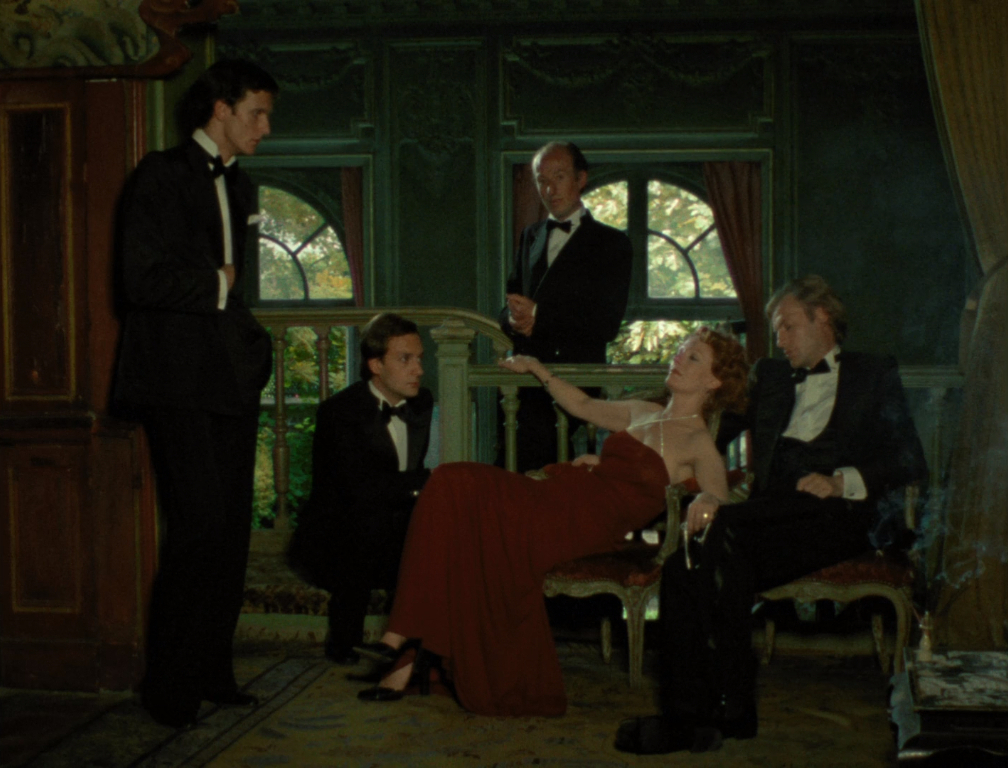
In a few respects India Song is a lot like Marguerite Duras’ 1972 feature Nathalie Granger. Both movies are told in fragments, even if India Song eventually coalesces into a complete story. Both are set mainly in a house and its gardens, where the residents are opaque, largely mute, unintelligible, a total challenge to the viewer. In each film a strange man enters the house, full of trepidation, giving the story its first emotional foothold and allowing the viewer to enter the movie at the same time and in the same manner he does – apprehensively, longingly, totally conscious of his position as an outsider. In Nathalie Granger he’s a comically inept washing machine salesman played by Gérard Depardieu; in India Song it’s the vice-consul of Lahore. Both men can be viewed as proxies for the viewer as we approach a movie that doesn’t readily invite us inside.
Duras followed India Song with a kind of sequel whose title quotes the voix intemporelle voiced by Duras herself during the gathering at the top of the stairs, the last shot in the embassy. Asked what the vice-consul is bellowing outside, she answers: “Son nom de Venise dans Calcutta désert” – i.e. Madame Stretter’s Venetian maiden name, Ana Maria Guardi. Her Venetian name is thus equivalent to the vice-consul’s agony, and by extension to the man himself insofar as he’s defined by his pain; but it’s also equivalent to her French name, to Madame Stretter herself, and to the generalized fear of that off-screen voice right before Stretter is introduced. Like a sun, her name radiates equivalence in all directions. Isn’t she also equivalent to the fading sun in the opening shot – a dying breed of colonial aristocrat, tired of her life?
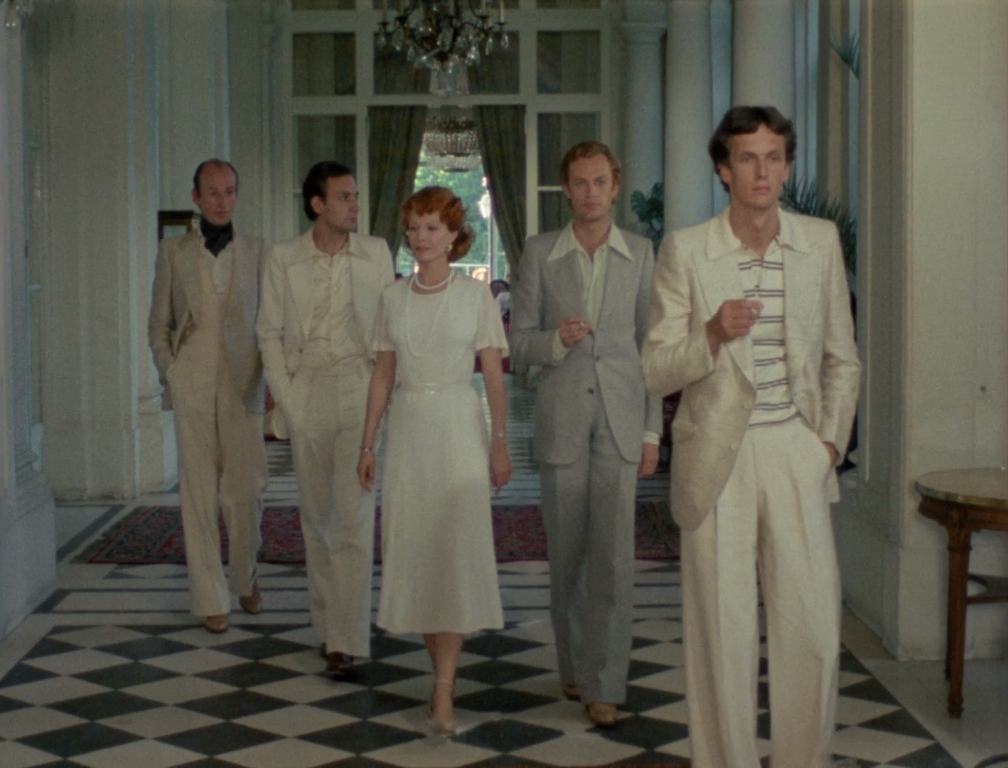
Anne-Marie Stretter clearly stands for more than herself. Her dissolute life amid the hunger and disease of the Third World makes her, on one level, representative of the greater West. Her death is one of “those European suicides that increase with the hunger that they never suffer” (one of the narrators’ fragmentary lines). Her “leprosy of the heart” contrasts with the real leprosy outside. But categories like “the West” tend to dissolve into larger categories that spread into the lands once colonized. Her numbness to life is a symptom of our times, less and less confined by geography, and a movie like India Song has the advantage of presenting it as a recognizable object of fear without requiring a complex accounting of its causes. Rather the movie wishes to point the way out.
Of all the poetic and structural equivalencies that make India Song so resonant, the most powerful and inventive must be the way it establishes an equivalence between the viewer and the characters. Of course most movies try to do this, but in cheap ways that numb the viewer, like encouraging identification with a character. India Song doesn’t play that game; if anything the opaque characters shun viewer identification. Duras does this in Nathalie Granger too, but here the separation of voice from image – there is no synchronized dialogue, and most of the voices do not even belong to the image at all – puts us at a further remove. But this distancing is also a challenge, an invitation, to look more closely.
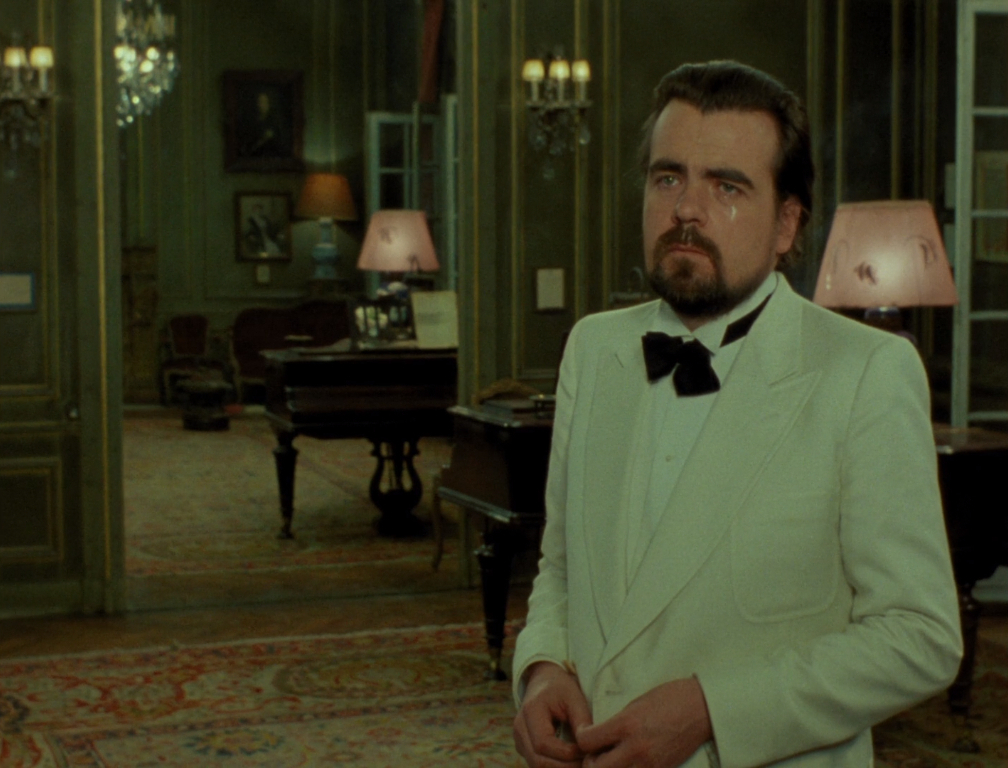
More than any other filmmaker after Antonioni, Duras takes up his project of teaching us to see, and like Antonioni she understands that extraneous dramatics distract from genuine vision. Both directors are commonly associated with “ennui” because their characters are often numb to life, but this numbness is precisely what they want to challenge in the viewer. When the narrator says she’s afraid of Anne-Marie Stretter, it’s because this numbness, this internalized leprosy, has become the hallmark of our times. Most people won’t commit suicide like she does, but they eagerly commit the smaller suicide of killing time. The alternative is not to make ourselves busier, but to make our time count – which we do by looking directly at life with renewed wonder. From this point of view, the voix intemporelles, rather than standing as obstacles, become intermediaries between the viewer and the mysterious world onscreen.
The object of watching India Song is not, like most movies, to coast along passively on the story, treating its characters as extensions of our own nervous systems through which we experience new things. Rather, although they remain forever “other” to us, the challenge is to see them as recognizable human beings. Anne-Marie Stretter, on the verge of suicide and unable to find wonder in life, should inspire a certain fear for her life as well as for ours, but this abstract fear requires a concrete equivalent which is found in the vice-consul. Again, the off-screen voices are there to guide us: “Isn’t there in each of us a chance, just one, of being like him in Lahore?” As much as we might recoil from his behavior, the point is not to judge him but to ask ourselves what will save us from his fate.
CONNECTIONS:
Black Narcissus – European vision of India filmed entirely in Europe
Nathalie Granger – Nameless character who enters the house uninvited and adds narrative weight to the fragmentary story
The Discreet Charm of the Bourgeoisie – Diplomat shooting dogs from a balcony
Baxter, Vera Baxter – Nameless character who enters the house uninvited and adds narrative weight to the fragmentary story; contrast and equivalence between a modern suicidal housewife and another woman from far away or long ago
Enemy – Ambiguous hinge between two equivalent characters: shadow on steps between Laotian beggar and vice-consul, spider-head between Anthony and Adam